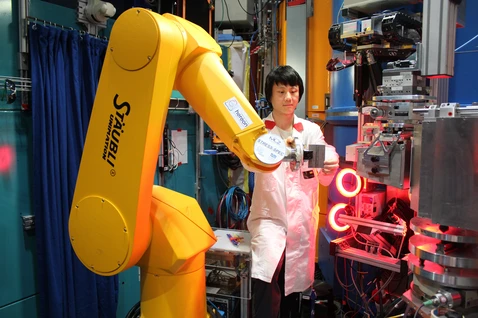A robotic assistant at FRM II
Wissenschaft, STRESS-SPEC |

Challenges in sample placement
The Heinz Maier-Leibnitz Research Neutron Source (FRM II) in Garching near Munich is one of the world’s leading facilities providing neutrons for scientific and industrial measurements. As demand continues to grow, one of the main bottlenecks is the time needed to manually position and align samples in the beam path. In addition, conventional sample tables have limited movement and flexibility in how they can rotate.
Robotics as a solution
Fortunately, FRM II is home not only to reactor physicists and instrument scientists, but also to engineers like Lijiu Wang. As part of his PhD, he is developing an innovative robotic system that will offer greater flexibility and enable faster operation. The robotic arm, currently installed at the STRESS-SPEC instrument, can already position samples with sub-50-micrometer accuracy thanks to an earlier project.
Digital twin for precision measurements
“I’m working on automating key steps in a measurement series,” explains Lijiu Wang. “This includes calibrating the instrument, switching samples, and aligning them with the neutron beam – all without human intervention.”
A core element of this system is collision-free path planning. Lijiu Wang further explains: “To help the robot move precisely and avoid contact with sensitive scientific equipment, we create a digital twin of its surroundings. Cameras track the exact position of the samples, enabling high accurate placement.”
Technology with broader applications
Dr Michael Hofmann, instrument scientist at STRESS-SPEC and Wang’s PhD advisor, sees broader potential: “If this camera-based localization system proves reliable, it could be adapted for many other similar scientific instruments to allow faster and more accurate positioning of samples or components.”
He also sees benefits beyond research: “Students could easily learn how to operate and program such a system. Combined with a simulation tool, it could even be used for hands-on training.”
“This way,” he adds, “students can safely practice and gain a clearer understanding of how neutron experiments work – even before entering the lab.”
Original publication:
Landesberger, M., Kedilioglu, O., Wang, L., Gan, W., Kornmeier, J. R., Reitelshöfer, S., … & Hofmann, M. (2024). High-Precision Visual Servoing for the Neutron Diffractometer STRESS-SPEC at MLZ. Sensors, 24(9), 2703
DOI: https://doi.org/10.3390/s24092703